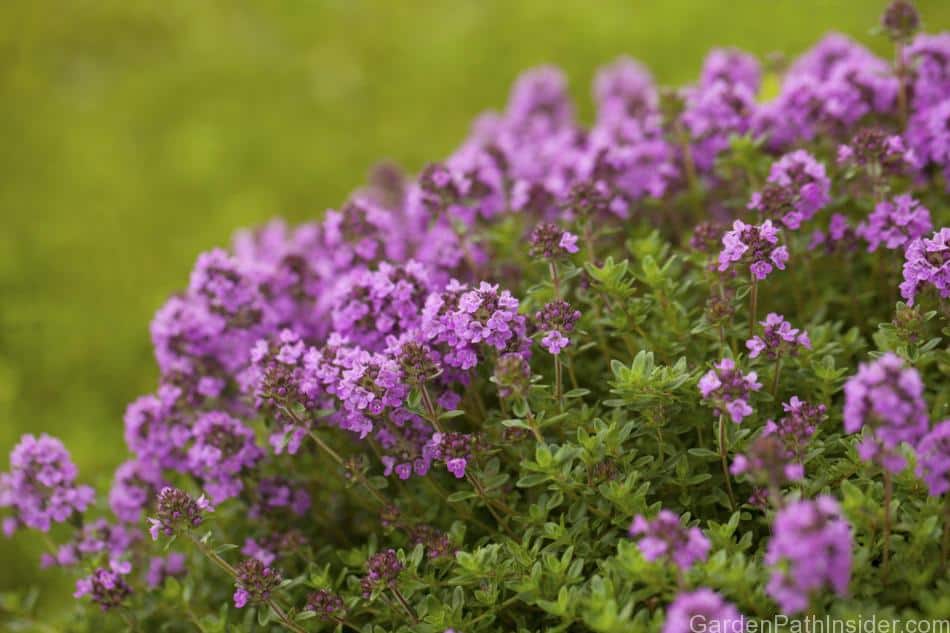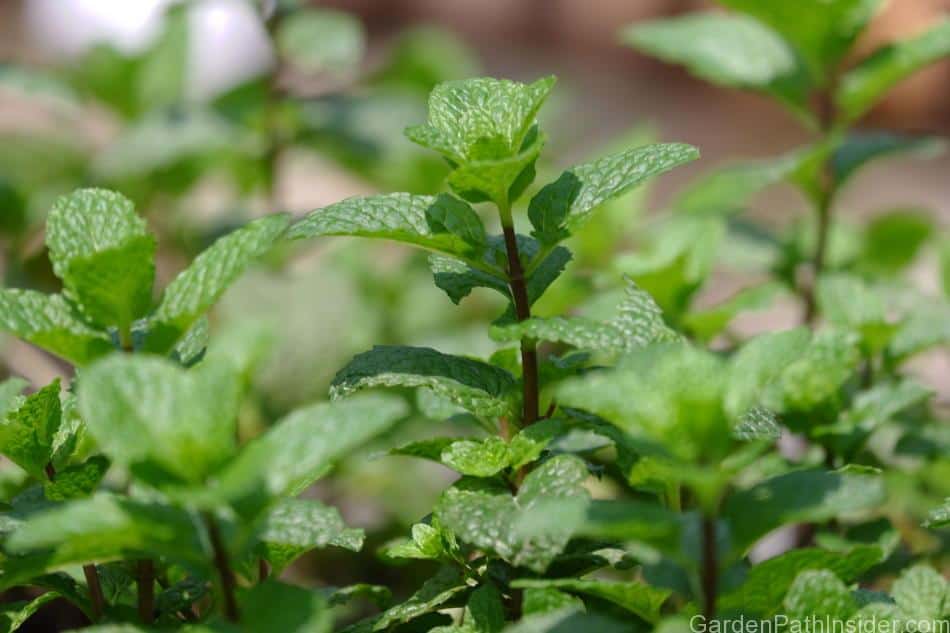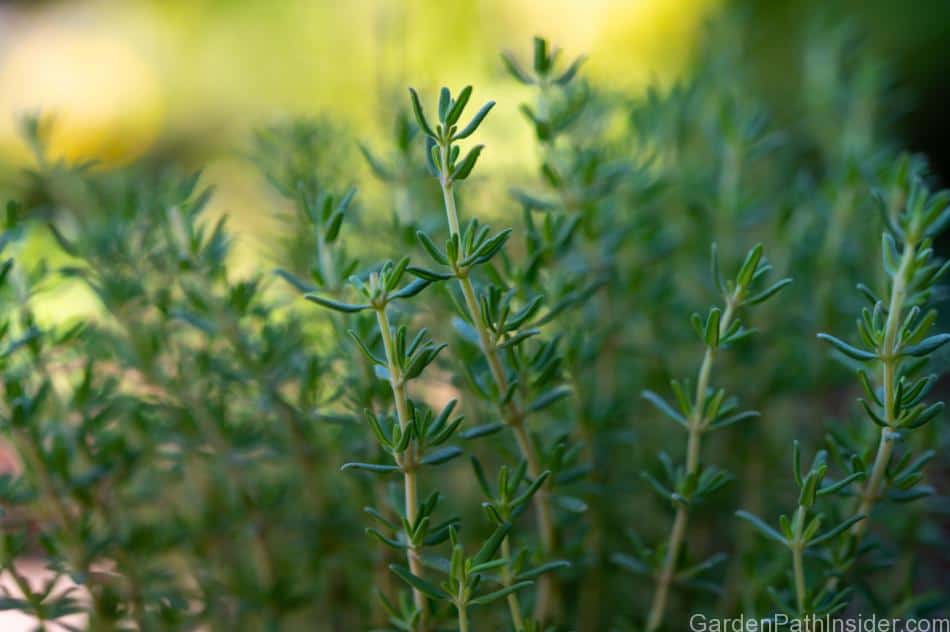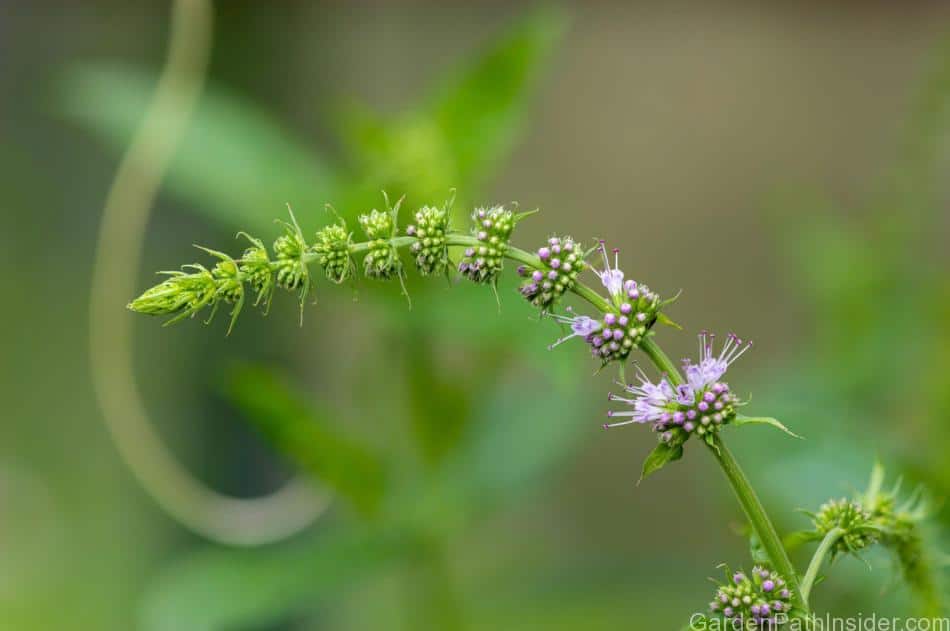
Thyme and mint are both fragrant herbaceous perennials, used to add their unique flavors to many delicious food and beverage recipes. When grown in the correct conditions, thyme and mint are excellent companion plants to add to your herb garden.
Thyme and mint should not be planted together in the same growing bed, as thyme requires drier sandy soil and mint requires moist well-draining soil. Also, mint is an invasive species that can overtake its growing area. Thyme and mint thrive grown close together in separate containers, as mint repels pests like aphids and beetles that may damage thyme.
Thyme and mint are great companion plants when grown close to each other in separate containers with their optimal soil and garden bed requirements. Below are outlined the steps to successfully grow thyme and mint in your herb garden.
Overview of Thyme
Thyme (Thymus vulgaris) is a flavorful herbaceous perennial that grows up to 12 inches tall (30cm). Thyme is used in more savory culinary dishes; often paired with meats, fish, vegetables, and even cheeses.
Native to the Mediterranean, thyme thrives in fertile to sandy soils and full sun exposure. This woody textured herb comes in several varieties of culinary or ornamental. Each grows in a different style, from tall bush-like varieties to a variety that grows low and spreads efficiently often used as ground cover.
Thyme Summary
- Height: up to 12 inches tall (30cm)
- Sun: Full Sun optimal, partial sun is still acceptable
- Soil: Rocky, sandy
- Water: Requires dryer soil, add water slowly, and let the water absorb fully to avoid overwatering.
Varieties of Thyme
Creeping pink thyme: is a perennial ground cover variety of thyme with pink to purple flowers. This thyme grows up to 3 inches (7cm) in high. Creeping pink thyme needs full sun and is efficient at conserving water making this variety perfect for dryer sandy soils.
English thyme (Thymus vulgaris): English thyme is a culinary variety of thyme with pink fragrant flowers and deep green leaves. English thyme grows up to 12 inches (30cm) tall with pink flowers and dark green leaves. Plant English thyme in full sun with well-draining soil as thyme requires dryer sandy soils to thrive.
Lemon thyme (Thymus x citriodorus): Lemon thyme is a culinary variety of thyme that is low maintenance and resistant to deer and drought. Grown in full sun this thyme blooms in mid-summer, growing up to 12 inches (30cm) tall with up to 24 inches (60cm) in spread. Lemon thyme thrives in dry sandy soil.
Overview of Mint
Mint is an herbaceous perennial often used in fresh beverages and other culinary treats. Some varieties of mint reach the height of 36 inches tall (91cm) though most grow to 18 inches (45cm).
Mint roots grow shallow in the soil, though the mint plant will send out roots horizontally called rhizomes or often referred to as runners. Mint is an invasive species and the rhizomes spread fast, easily taking over a garden bed within a season.
Mint planted in garden beds should be planted in raised beds or in-ground with a garden bed barrier perimeter. Garden bed barriers are thin dividers planted just below the soil level to keep the mint runners from overtaking the garden.
Mint roots only grow to about 8 inches (20cm) deep, so the barriers will not be intrusive in your yard or garden. Garden bed barriers can be found online or at your local home store. You can also get creative and build your own if you have some scrap materials on hand.
Mint Summary
- Height: 18 to 36 inches tall (45cm to 91cm)
- Sun: Full sun
- Soil: Fertile to alkaline soil
- Water: Keep soil moist watering as needed
Varieties of Mint
Chocolate mint (Mentha x piperita ‘Chocolate’): Chocolate mint has a subtle chocolate flavor blended with mint. This is a great addition to teas and treats. Chocolate mint grows up to 24 inches tall and 24 inches wide (60cm tall, 60cm wide).

Spearmint (Mentha spicata): is a classic variety of mint and has been used in candies, chewing gum, and teas for decades. Spearmint can grow up to 24 inches tall and 24 inches wide (60cm tall, 60cm wide). Bees are also attracted to spearmint, and more bees in the garden will boost pollination.
Container Growing Space Requirements
Mint and thyme are great companion plants when grown next to each other in separate containers or different garden beds. Both mint and thyme have varieties that range in size from small indoor sizes to large backyard varieties.
First, identify the variety that you want to grow and pick the corresponding sized container. There are endless styles of containers and clay pots to choose from. The main feature to look for when selecting a container or pot for mint or thyme is adequate drainage.
Clay pots are my first choice for my container garden. Plastic growing containers have their unique advantages and are often less expensive. If you have a container without drainage holes, then you may need to drill out a few yourself.
If you are planting mint in a garden bed it’s recommended to raise the bed, or plant garden bed barriers in a perimeter around the mint to keep it from taking over the garden.
Soil Needs for Thyme and Mint
Planting thyme and mint in separate containers is recommended as both herbs have different soil needs. Thyme requires dryer rocky-sandy soil and can thrive in dryer climates. Mint requires moist fertile to alkaline soil to grow and develop.

Water Needs for Thyme and Mint
Mint will require moist soil to thrive as mint grows fast and spreads rapidly. Water as needed to keep the soil moist.
Thyme requires less water than mint and thrives in slightly dryer sandy soil. The sandy soil will help maintain a limited moister environment for the plant.
Check each plant daily, and in extreme heat check the plant twice daily. It is most efficient to water your garden early in the morning or later in the evening when the temperatures are the coolest. Avoid watering when the sun is out in the middle of the day as much of the water will evaporate from the sun and heat before the plants are able to absorb and utilize the water.
Light Needs for Thyme and Mint
Both thyme and mint require full sun of 6 to 8 hours per day, with a minimum of at least 4 hours per day. Planting these herbs in containers provides the freedom to move the containers around your garden during the season to chase the optimal sunlight exposure. Potted herbs can also be brought indoors during cold weather to prolong the growing season.
Harvest Time for Thyme and Mint

Mint Harvest
The leaves of the mint plant are the edible harvest from mint. Mint leaves can be harvested starting in early summer when the mint plant begins to reach mature height. The plant will continue to grow and provide leaves to consume through mid-fall or the first frost. Mint leaves are edible as soon as they appear on the plant. However, it is best to let the leaves grow to maturity and support the plant’s development.
Thyme Harvest
Thyme is mainly used as a flavoring herb in meal prep. The leaves and stem are cut off the plant in sprigs and used fresh or dried; mostly in savory meals including meats, fish, vegetables, and even cheeses. Thyme is most flavorful before it blooms.
To harvest thyme, look for a sprig on the plant that has not started to flower or bloom. Clip the sprig off the plant and rinse before use.
If you are using fresh thyme you can store it in the refrigerator; or wrapped in paper towel, placed in a large zip-close bag, and store in the freezer for fresh herbs later.
Drying thyme will preserve the herb for later use in food prep. Clip the sprigs and hang upside down until fully dried, then the dried thyme can be stored in glass spice jars.
Pro tip: When harvesting herbs, use a sharp pair of scissors to cleanly cut the stems at the node of each plant. This will help to avoid tearing or breaking the main stalk of the plant during harvest.
Summary Chart for Thyme and Mint
| Plant | Soil type | Water needs | Light needs | Bloom time | Harvest time |
| Mint | Loose well-draining fertile soil | Keep the soil slightly damp to moist. Water as needed | Full sun | Spring/Summer | Mint leaves are edible at any time, though best practice Is to wait until the plant gets at least 6 inches tall (15cm) |
| Thyme | Sandy soil | Drought resistant and able to tolerate dryer soils | Full sun to partial sun | Summer to early fall | Thyme is ready for harvest from summer to fall. Though summer months are better to harvest the thyme at its peak |
Cover image: Thyme (Thymus vulgaris) blossoming_© Jurate Buiviene/123rf.com
